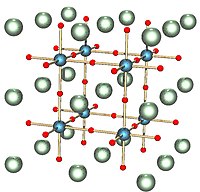
Photo from wikipedia
The halide perovskite material has attracted vast attention as a versatile semiconductor in the past decade. With the unique advantages in physical and chemical properties, they have also shown great… Click to show full abstract
The halide perovskite material has attracted vast attention as a versatile semiconductor in the past decade. With the unique advantages in physical and chemical properties, they have also shown great potential in photocatalytic applications. This review aims at the specific design principles triggered by the unique properties when employing halide-perovskite-based photocatalytic systems from the following perspectives: (I) Design of photoelectrocatalytic device structures including the n-i-p/p-i-n structure, photoelectrode device encapsulation, and electrolyte engineering. (II) The design of heterogeneous photocatalytic systems toward the hydrogen evolution reaction (HER) and CO2 reduction reaction, including the light management, surface/interface engineering, stability improvement, product selectivity engineering, and reaction system engineering. (III) The photocatalysts for the environmental application and organic synthesis. Based on the analyses, the review also suggests the prospective research for the future development of halide-perovskite-based photocatalytic systems.
Journal Title: Frontiers in Chemistry
Year Published: 2020
Link to full text (if available)
Share on Social Media: Sign Up to like & get
recommendations!